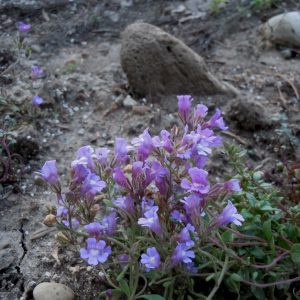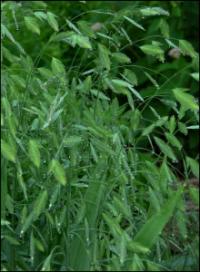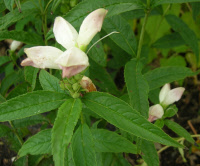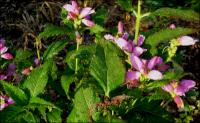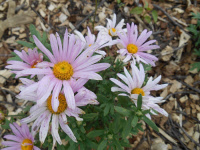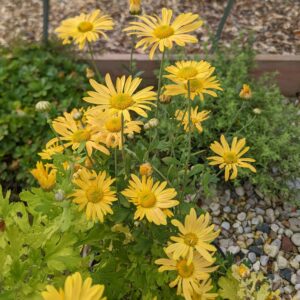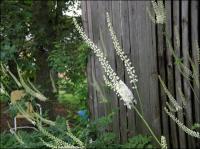Our Plants
Showing 129–136 of 587 results
-
Chaenorhinum glareosum Dwarf snapdragon Z 5-9
Rare plant. Spires of tiny purple to blue trumpets with yellow throats spring, summer & fall. Love this itsy plant.
Rare plant. Spires of tiny purple to blue trumpets with yellow throats spring, summer & fall. Love this itsy plant.
Size: 4” x 9-12” semi-trailing cushion
Care: sun to part-shade in well-drained soil
Native: Spain
Wildlife Value: Attracts bees, butterflies and birds.1st described in 1838. Chaenorhinum means “honey lotus” in Greek.
-
Chasmanthium latifolium Northern Sea oats Z 5-9
Graceful, pendulous oat-like spikes
In August – December Northern sea oats bear pendulous panicles of oat-like spikelets, emerging green and turning bronze. They hang on all winter.
Size: 36" x 24"
Care: full sun to part shade in any soil
Native: Eastern U.S., New Jersey to Texas
Wildlife Value: attracts butterfliesIntroduced by Michaux (1746-1802) extraordinary French plant hunter, who searched much of eastern No. America for plants. Indians ate the seeds for food. Used ornamentally since Victorian times for fresh and dried arrangements.
-
Chelone glabra White turtlehead Z 3-8
Spikes of pink over-tones on white, two-lipped, turtlehead shaped blooms in fall
Spikes of pink over-tones on white, two-lipped, turtlehead shaped blooms in fall
Size: 24-36” x 12”
Care: sun to part shade in moist to moist well-drained soil, tolerates clay.
Native: eastern North America incl Wisconsin
Wildlife Value: Pollen for bumblebees. Breeding site for Baltimore Checkerspot butterflies. Deer resistant.The name Chelone originated with French colonial settlers in Nova Scotia before 1700. They called this “La Tortue,” meaning “turtle” in French. The word chelone is Greek for tortoise. A tea brewed from the leaves was said to increase the appetite.
-
Chelone obliqua Rose turtlehead Z 5-9
Rich pink turtlehead shaped blooms in fall
OUT OF STOCK
Rich pink turtlehead shaped blooms in fall
Size: 16-24" x 12"
Care: Part shade moist to moist well-drained soil, tolerates clay
Native: Central and southeastern America
Wildlife Value: Attracts Baltimore Checkerspot butterflies.The name Chelone originated with French colonial settlers in Nova Scotia before 1700. They called this plant’s white-flowered relative (Chelone glabra) “La Tortue,” meaning “turtle” in French. This pink one found in 1752 by Virginia plantsman John Clayton and sent to John Bartram in Philadelphia in 1765. Called the “red Chelone.” A tea brewed from the leaves was said to increase appetite.
-
Chrysanthemum x rubellum ‘Clara Curtis’ Z 4-9
Late-summer - fall, sprays of large, single pink daisies, each with a golden eye.
Late-summer – fall, sprays of large, single pink daisies, each with a golden eye.
Size: 2’ x 2’
Care: Sun to part shade in any soil. Pinch back half way in June to keep plants bushy.Korean hybrids, of which this is one, created in 1937 by crossing early flowering mum with Chrysanthemum coreanum.
-
Chrysanthemum x rubellum ‘Mary Stoker’ Z 4-9
Sprays of large, single warming yellow daisies, blushed with apricot top a bushy mound of light green leaves, Blooms late-summer to late-fall
OUT OF STOCK
Sprays of large, single warming yellow daisies, blushed with apricot top a bushy mound of light green leaves, blooms late-summer to late-fall
Size: 1-2’ x 2-3’ and spreading
Care: Full sun to part shade, tolerates normal, sandy or clay soil
Wildlife Value: Attracts bees, butterflies and birds. Deer resistant.One of the rubellum hybrids, Hybridized in the 1930’s
-
Cimicifuga racemosa syn. Actaea racemosa Snakeroot, Black Cohosh or Bugbane Z 3-8
Majestic milky white candles covered with buds like pearls that open to frilly balls in August
Majestic milky white candles covered with buds like pearls that open to frilly balls in August
Size: 4-6' x 2-4'
Care: sun to shade in any soil
Native: east N. America, Wisconsin native
Awards: England’s Royal Horticultural Society Award of Merit.Cimicifuga is from cimex (Latin) meaning bug and fugere meaning to drive away. The common name “bugbane” also refers to the plant’s odor which repels insects. The common name “cohosh” came from an Algonquin Indian word for rough referring to the feeling of the root. American Indians used its roots medicinally as an astringent, an antidote to poison and snakebites and to stop coughing. Roots infused in alcohol reduced pain from rheumatism (Cherokee.) Root considered an aphrodisiac, reputedly increased estrogen and reduced hot flashes. “Like most folk remedies, it was used to treat a wide variety of multiple complaints: bronchitis, cholera, fevers, nervous disorders, lumbago, rheumatism, snakebites. It was also used in childbirth and for menstrual irregularities.” Monticello.org Collected by John Bartram, c. 1750. Philip Miller (1768) reported this “deserves a place in the shady borders.” Thomas Jefferson listed this in his book Notes on the State of Virginia, 1787.
-
Clematis ‘Madame Julia Correvon,’ Z 4-9
Rich-red petal-like tepals 3-4” across bloom from June to September, encircling yellow stamens, on this vigorous, climbing vine
OUT OF STOCK
Rich-red petal-like tepals 3-4” across bloom from June to September, encircling yellow stamens, on this vigorous, climbing vine
Size: 12’ x 3-6’
Care: Sun to part shade in moist, well-drained soil. Cut back in early spring about 1’ above the soil level and just above a a pair of buds.
Wildlife Value: deer and rabbit resistant. Walnut tolerant. Attracts bees and butterflies.
Awards: Royal Horticultural Society Award of Garden MeritFrancisque Morel, Clematis breeder in Lyon France, grew this Clematis in 1900 from a cross of Clematis viticella ‘Rubra grandiflora’ and Clematis ‘Ville de Lyon,’ Named for the wife of the award-winning Geneva Switzerland nurseryman and author specializing in alpine plants, Henri Correvon (1855-1935). Nurseries at at 2 Chemin Dancet, 2 Plainpalais and Chêne-Bourg. Obituary https://www.nature.com/articles/144183b0.

